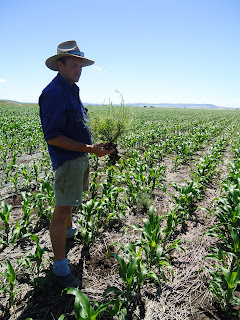
Both Catherine and Charlie suggested I tried to visit Kym Green – a cherry and apple grower in the hills near Adelaide. It’s mid cherry harvest at the moment so I was very grateful when Kym agreed to meet me. Kym uses a mixture of compost, conventional chemicals and biodynamic preparations in conjunction with radionics to produce beautiful cherries that are the best I’ve ever tasted. Radionics is the practice of using a machine to ask the plant what nutrients it is short of and what product or mix of products would satisfy that need best.

Kym sits on many of the industries boards and regularly speaks at conferences in America. He has won many awards for his innovations – including using bird nets over the cherries. All the cherries are picked and graded by hand – they use very cold water to help bring the temperature of the cherries down (from around 40 C) to preserve the colour, flavour and texture of the fruit.

Kym uses grasses as green manures ‘in crop’ and green manure mixtures between re planting. This has all helped Kym raise his soil organic matter from 1.5 to 6%. The orchards are perched on steep hills, all the grass is mowed between rows – a job I wouldn’t queue up for on those slopes! Kyms methods are producing very healthy trees and juicy fruit.
A quick spree in the R M Williams shop in Adelaide today confirms the daily liveweight gain theory!

Kym sits on many of the industries boards and regularly speaks at conferences in America. He has won many awards for his innovations – including using bird nets over the cherries. All the cherries are picked and graded by hand – they use very cold water to help bring the temperature of the cherries down (from around 40 C) to preserve the colour, flavour and texture of the fruit.

Kym uses grasses as green manures ‘in crop’ and green manure mixtures between re planting. This has all helped Kym raise his soil organic matter from 1.5 to 6%. The orchards are perched on steep hills, all the grass is mowed between rows – a job I wouldn’t queue up for on those slopes! Kyms methods are producing very healthy trees and juicy fruit.
A quick spree in the R M Williams shop in Adelaide today confirms the daily liveweight gain theory!

 David and Catherine shared their library with me - such an impressive collection of both old and new agricultural literature – my new reading list is born! They were also kind enough to share some of their home made goodies with me – the whole family are extremely talented cooks with such luxuries as homemade ice cream, sorbet, bread and veggies all from their own farm I’ll be chasing Mr Peck for the best Nuffield Daily Liveweight Gain!
David and Catherine shared their library with me - such an impressive collection of both old and new agricultural literature – my new reading list is born! They were also kind enough to share some of their home made goodies with me – the whole family are extremely talented cooks with such luxuries as homemade ice cream, sorbet, bread and veggies all from their own farm I’ll be chasing Mr Peck for the best Nuffield Daily Liveweight Gain!
 My farmer sponsorship group - BOGS suggested I visit Charlie whilst I was over here - a popular member of their worshipful company of farmers management course. I arrived at a house which resembled an oppulent vineyard, was handed a beer (and an afterthought token glass of water) and we sat down to chat - 3 hours a plate of nibbles and several beers later we had established where each of us was on our quest to balance our nutrition - Charlie is about 10 years in front so I had a lot to gain!
My farmer sponsorship group - BOGS suggested I visit Charlie whilst I was over here - a popular member of their worshipful company of farmers management course. I arrived at a house which resembled an oppulent vineyard, was handed a beer (and an afterthought token glass of water) and we sat down to chat - 3 hours a plate of nibbles and several beers later we had established where each of us was on our quest to balance our nutrition - Charlie is about 10 years in front so I had a lot to gain!










